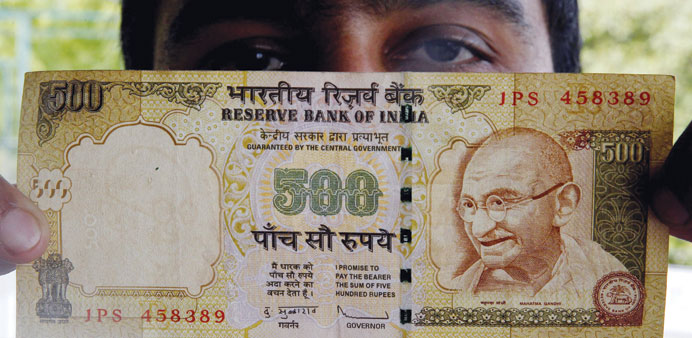An Indian man displays a 500-rupee note in New Delhi yesterday. The rupee yesterday fell to a record low of 60.73 against the dollar, pushed by demand for the greenback from domestic importers, withdrawal of funds by foreign investors and a slump in several Asian currencies.
Bloomberg/Mumbai
|
|
India’s rupee plunged to a record 60.7650 per dollar as investors favoured the greenback after latest data bolstered the US economic outlook. Bonds and stocks declined.
The Bloomberg Dollar Index, which tracks the US currency against 10 major trading partners, rose after data on Tuesday showed US new-home sales and consumer confidence exceeded economists’ estimates. Federal Reserve Chairman Ben S Bernanke said on June 19 the central bank may phase out a stimulus programme this year should the US economy improve.
“This currency weakness was not triggered by India’s fundamentals,” Anubhuti Sahay and Samiran Chakraborty, Standard Chartered economists in Mumbai, wrote in a report yesterday. “A weaker rupee can add to inflationary pressure, widen the fiscal deficit and slow capital inflows, without having a positive effect on the current-account deficit.”
The rupee slid 1.7% to 60.73 per dollar in Mumbai, according to prices from local banks compiled by Bloomberg. It has fallen 7% this month, the world’s worst performance, and slumped 10.6% this quarter, the most since 1991. The plunge will inflict “significant damage” on India’s economy and the central bank’s ability to stem the drop is limited as currency reserves are enough to cover only about seven months of imports, according to Royal Bank of Scotland.
The Reserve Bank of India sold dollars, two traders with knowledge of the matter said, asking not to be named as the information isn’t public. The bank sold “small amounts” to smooth volatility rather than protect a certain level, one of them said. The country’s foreign currency stockpile was $290.7bn as of June 14, down from an all-time high of $321bn in 2011, official data show.
The Bank of New York Mellon India ADR Index slipped 0.3% as of 10:47 am in New York after the S&P BSE Sensex fell 0.4% to 18,552.12 at the close in Mumbai. The 50- stock CNX Nifty Index on the National Stock Exchange of India lost 0.4% to 5,588.70. Its June futures settled at 5,581.10. India VIX, which gauges the cost of protection against losses in the Nifty, fell 0.3%.
The Sensex has dropped 4.5% this year, reversing gains after climbing to a two-year high on May 17, as foreign funds extended a sell-off of local shares amid the fall in the currency. The gauge trades at 12.4 times projected 12-month profits, near to the cheapest level since April, compared with the MSCI Emerging Markets Index’s 9.3 times.
Foreign investors pulled $256mn from domestic shares on June 24, a 10th day of outflows, data compiled by Bloomberg show. That pared this year’s purchases to $13.8bn, still a record for the period, the data show.
One-month implied volatility, a gauge of expected moves in the exchange rate used to price options, rose 68 basis points, or 0.68 percentage point, yesterday to 12.59%.
Bharti Airtel, India’s largest mobile-phone operator, slumped 6% to Rs277.7, its steepest drop since August 9. Tata Motors, the owner of Jaguar Land Rover, slid 3.1% to Rs272.65, its seventh day of fall. Mahindra & Mahindra, India’s largest maker of sport-utility vehicles and tractors, plunged 4.8% to Rs911.15, the most since January 30, 2012. Aluminum producer Hindalco Industries decreased 2.4% to Rs94.7. HDFC Bank, India’s most valuable lender, fell 1.8% to Rs622.85.
Indian bonds fell, sending yields to a two-month high, on speculation the rupee’s plunge will limit the scope for the RBI to further cut interest rates. A sustained 10% drop in the rupee adds 150 basis points to 200 basis points to wholesale-price inflation, Standard Chartered estimates.
The yield on 8.15% notes due June 2022 rose 10 basis points, or 0.10 percentage point, to 7.79% in Mumbai, according to the central bank’s trading system. That is the highest level for the note since April 17.
The jump in yield prompted the Fixed Income Money Market and Derivatives Association of India to ease an indicative daily band. The trading band was doubled for all maturities, said Debendra Kumar Dash, a fixed-income trader at Development Credit Bank in Mumbai. The limit for 10-year bonds was raised to 20 basis points over Tuesday’s closing yield level, compared with 10 basis points allowed usually, he said.
The one-year interest-rate swap, a derivative contract used to guard against fluctuations in funding costs, rose 11 basis point to 7.54%, the highest level since May 26, data compiled by Bloomberg show.
Overseas funds have pulled $1.5bn from domestic shares in June, poised to become net sellers for the first month since May 2012. They have also cut rupee debt holdings by $5.1bn after buying in each of the previous six months. The sell-off is the reason for the rupee’s slide, the RBI said in a June 17 statement, as it kept interest rates unchanged for the first time in four meetings.
“The 60 level is a very attractive level for the currency, I don’t see much depreciation from current levels.” Jeff Chowdhry, head of emerging-market equities at UK-based F&C Asset Management, which oversees about $150bn, told Bloomberg TV India yesterday. “The dollar strengthening has affected all emerging market currencies” and fundamentals of the Indian economy aren’t any worse than they were six months ago, he said.

